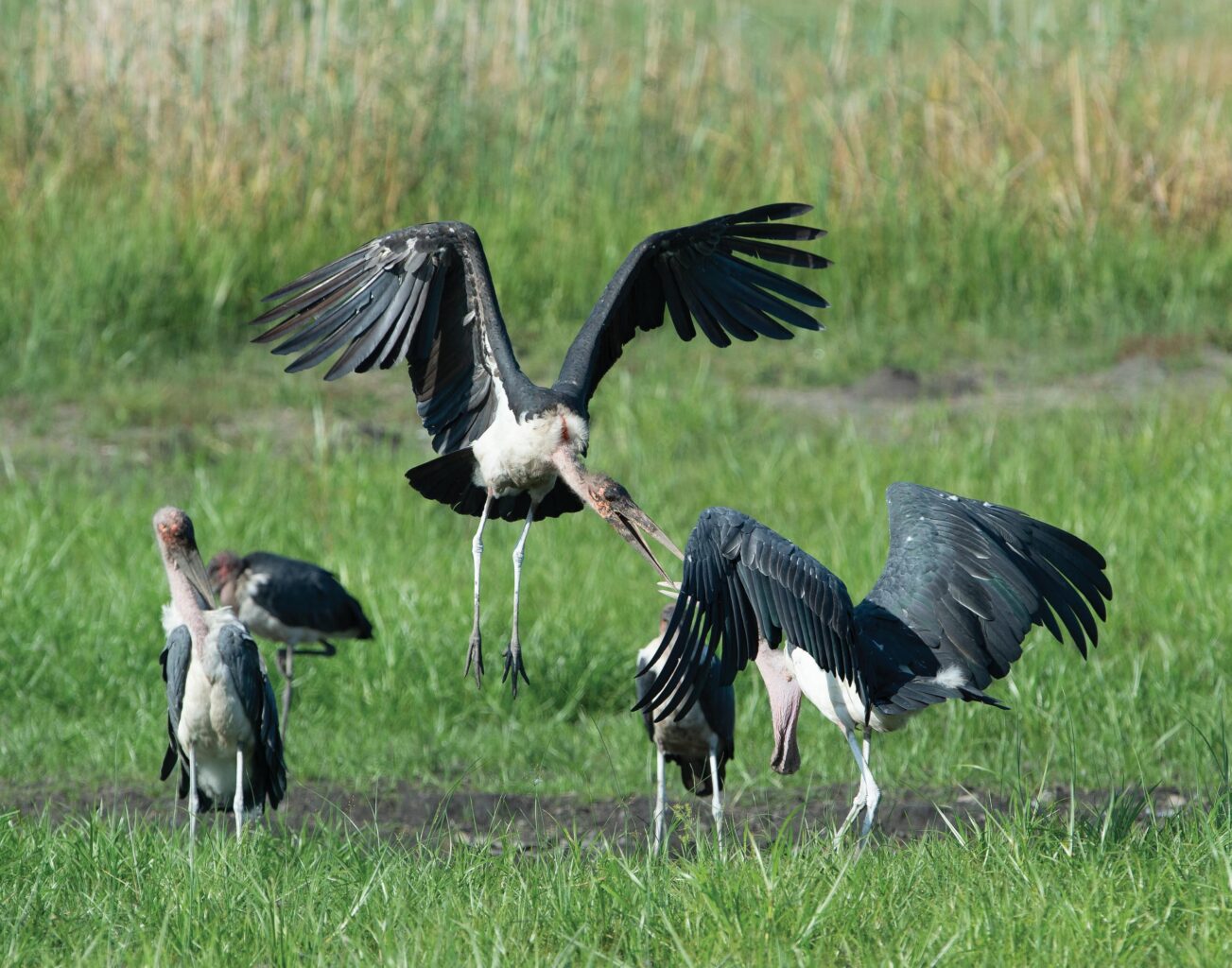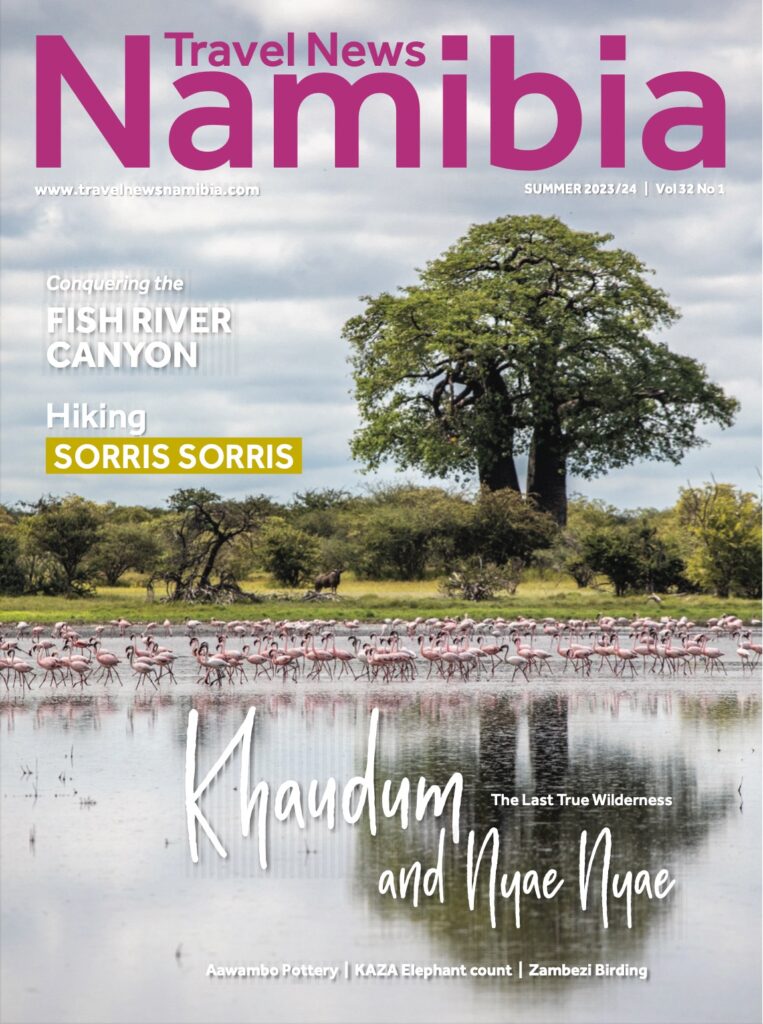

'Ugly'
is in the eye of the beholder
According to a dating website, Britons are the most ugly people in the world. Under the top ten most ugly people there are two women. Yes, you have guessed correctly, both had plastic surgery and Botox “surgery”. But obviously Google does not know everything and as a result does not rate the Marabou Stork under the top ten of ‘ugly’ as one would expect. Looking at the various names given to this stork I would differ: undertaker bird, old man in tailcoat, grim reaper, money in the bag around their neck and dreck bird. An African legend says that God ran out of animal parts and used left-over bird parts to make Marabou Storks. Unfortunately their habits do not improve their image.
Text Pompie Burger │ Photographs Pompie Burger
From the Summer 2023/24 issue
Their scientific name Laptoptilos cruminifer comes from Arabic murabit, which means quiet – one of their least unfavourable habits. The only sounds they do make is bill clapping and a sort of grunting uttered from their gular sac during breeding. By contrast, most ugly people are very vocal, see Donald Trump. The other positive habit of marabous is that they often wash their food in the water. One can add that they tend to wait patiently for other carrion eaters (vultures) to finish their meal at a kill before they take over for their daily bread. That means they are extremely patient. Unfortunately, the reason for this habit is not because they are nice, but because they cannot eat carrion that has not been cut into small edible pieces, which are usually left-overs from the vultures.
Having probably the biggest bill of all birds also puts them at the top of this list. It can measure up to 35 cm. This again fits into the greater scheme of the lesser aesthetically pleasing human ones having the biggest mouth. Marabous use their large bills to snap at each other, i.e. they are ill-tempered when there are differences to be settled.
Their wingspan is the widest of all land birds, four meters from tip to tip, putting them in the same category as flamingos and pelicans. The various albatross species have the largest, of more than four metres. This indeed enables marabous to glide on thermals up to 13,000 feet high. Fortunately, they have a very graceful flight. What one would not expect is that their feathers are used by humans for dress making! Marabous dry their wings by standing in full sun with their wings spread out.
The throat sac underneath a marabou’s neck is another feature of their exceptional appearance, and this is indeed just to add to their beauty. The sac can be retracted and when in full swing it can be up to 45 cm long. The fact that the sac is pink does not really improve its beauty. Apparently they can retract the sac at will or when necessary. Fortunately, they have this sweet habit of feeding their chicks with only fresh meat – how charming is that! The adult’s diet often includes pieces of metal, shoes and, yes, poo. A relatively new ecological/evolutionary habit is to hang around at garbage dumps and around human settlements eating hand-outs.
“Marabous have small beady eyes which are very strong, enabling them to see carrion from very high in the air and at great distances”
One of the Marabou Storks’ exceptionally sophisticated habits is to defecate on their legs, giving them a white appearance. Apparently the reason is to cool down by urohidrosis, since they do not spend that much time near water. The other two stork species that share this habit are the Openbill and White Storks. My rugby coach used to tell us when you sustain a sprain you must urinate on the injured part, which now makes sense to me, because I saw an ad on TV advertising this wonderful skin product that contains urea. Another marabou way of regulating temperature is by keeping their bill open and tongue out.
Marabous have small beady eyes which are very strong, enabling them to see carrion from very high in the air and at great distances. Their head and neck is devoid of any feathers. This is not for avoiding the need to comb their hair each morning, but to prevent blood and pieces of meat from sticking to the head when digging into a carcass. They are indeed very aware and particular about their appearance.
Here are a few interesting facts about Marabou Storks. They are gregarious but can sometimes be seen solitary. They breed in colonies on top of trees, mostly in areas north of Namibia. They are seldom, if ever, found breeding in Namibia. They lay a clutch of up to three eggs. The young chicks take four years to reach maturity. Young, subadult birds have a smaller bill and downy feathers on their head and neck. They have black upper parts and white under parts. Marabous can reach a height of up to 1,5 meters and weigh up to 9 kilograms. In contrast to the rest of the stork family they fly with their head pulled in. Their lifespan is about twenty-five years but in captivity they can reach over forty years.
A very interesting feature of some of the Marabou Storks is a reddish mass at the base of its neck. I tried to look for the function or meaning of this, but even Google did not come up with any satisfying solutions. On closer inspection one can also see red rings around the base of its legs which is not mentioned in any of the literature I have gone through. These colour changes might be related to breeding adaptations.
Despite being part of the stork family, marabous do not bring babies, except perhaps the odd politician. They also do not have any natural enemies, which puts them in a totally different category from most politicians. Couldn’t they just as well be classified as vultures?
Apparently their new scientific name is Politiciana vulgaris. TNN






